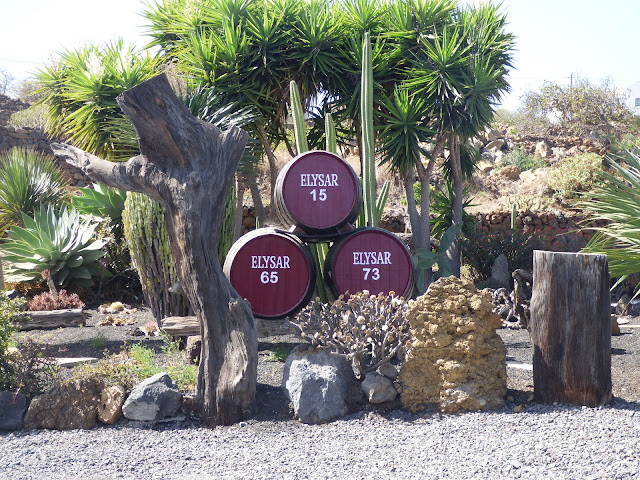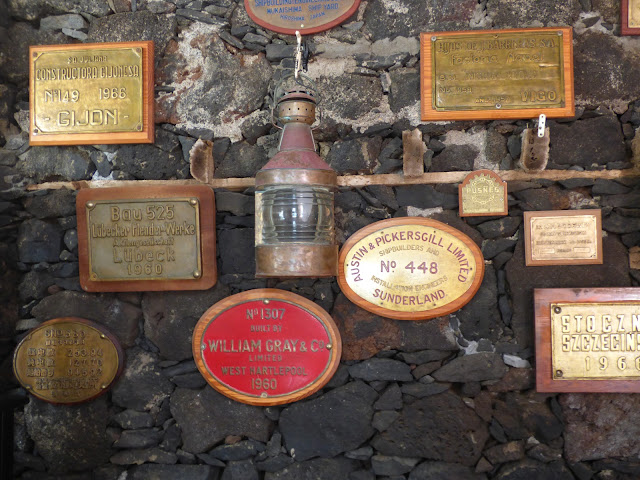Back to Sabinosa for the last time. Back to Extremadura tomorrow with some great memories of this small but diverse volcanic island off the coast of Africa in the deep blue waters of the ocean.
News from Finca al-manzil, Extremadura. Accommodation. Life on the finca, local trips and longer voyages
Thursday 27 September 2018
El Hierro: Adios.....
Last day of El Hierro holiday. A great ride on the old road across the island, winding up from the coast through thick laurel and fern woods, splendid pine forests and down to El Pinhal and La Restinga on the other side of the island on the so call Mar Calma, the calm sea. Before lunch we stopped at Taconal a rocky cove with really safe swimming in calm waters. Water temperature was wonderful, deep clefts in the rocks became delightful whirlpools as the tide came in and out.
Back to Sabinosa for the last time. Back to Extremadura tomorrow with some great memories of this small but diverse volcanic island off the coast of Africa in the deep blue waters of the ocean.
Back to Sabinosa for the last time. Back to Extremadura tomorrow with some great memories of this small but diverse volcanic island off the coast of Africa in the deep blue waters of the ocean.
Wednesday 26 September 2018
El Hierro: Charco de los Sargos and Punta Grande
A trek to Charco de los Sargos along the coast from Las Puntas, a rocky cove with small pool, a tiny haven along this wild coast. It was so hot today so the dip was great but really lethal slippery seaweed underfoot so had to slither into water over the rocks, was fine as the usually razor sharp volcanic rocks had been worn into beautifully smooth sculptural curves by the waves.
We walked back to Las Puntas and had a really welcome G&T at the wonderful restaurant/hotel La Punta Grande. It used to be a fishing boat storage wharehouse with a very dangerous sea access, there is an old crane which was used to hoist the boats out of the water as there is no safe harbour or beach. The restaurante has a great collection of ships' identification plaques and a slightly sinister ancient diving suit displayed in the corner.
We walked back to Las Puntas and had a really welcome G&T at the wonderful restaurant/hotel La Punta Grande. It used to be a fishing boat storage wharehouse with a very dangerous sea access, there is an old crane which was used to hoist the boats out of the water as there is no safe harbour or beach. The restaurante has a great collection of ships' identification plaques and a slightly sinister ancient diving suit displayed in the corner.
Tuesday 25 September 2018
El Hierro: La virgen de Los Reys fiesta
Only once every 4 years does the Virgen de los Reyes decend from her remote ermita on a long pilgrimage down to the coast at Valverde but every year there are two celebrations where she has a quick whizz around the ermita accompanied by dancers and musicians.
The dancers, men and women, wear a peculiar costume with white lace petticoats, a red apron with pockets and extraordinary headwear. The bonnet is variously decorated with flowers, feathers, sequins and long ribbon streamers. The dance is energetic and rythmic with castanets.
The carved wooden image of the virgen was brought to El Hierro in 1548 when a ship on its way to the new world was becalmed off shore, the crew ran out of food and water, they were provided with supplies by shepherds, in return they donated the only object of value on board, an image of the virgin, immediately a wind came and they could continue their voyage, it was the day of epiphany or Kings' day in Spanish and so she was named.
It is thought that these costumes must have been introduced to the island by early 16th century settlers from Galicia, Asturias, Portugal and Extremadura as there are very similar costumes in these places. They also reminded me of Morris Men which apparently could orginally have been Moorish Men, an ethnological puzzle.
The dancers, men and women, wear a peculiar costume with white lace petticoats, a red apron with pockets and extraordinary headwear. The bonnet is variously decorated with flowers, feathers, sequins and long ribbon streamers. The dance is energetic and rythmic with castanets.
The carved wooden image of the virgen was brought to El Hierro in 1548 when a ship on its way to the new world was becalmed off shore, the crew ran out of food and water, they were provided with supplies by shepherds, in return they donated the only object of value on board, an image of the virgin, immediately a wind came and they could continue their voyage, it was the day of epiphany or Kings' day in Spanish and so she was named.
It is thought that these costumes must have been introduced to the island by early 16th century settlers from Galicia, Asturias, Portugal and Extremadura as there are very similar costumes in these places. They also reminded me of Morris Men which apparently could orginally have been Moorish Men, an ethnological puzzle.
Tuesday 11 September 2018
Habiba: a little house at Finca al-manzil
At last the casita is finished, it's been through various stages over the years. From tack room with basic accommodation surrounded by saddles and outside organic loo, then an open studio, now one big room with bathroom, dressing room and outside kitchen on covered porch. It still has the flat roof with amazing views of the countryside and mountains, on eye level with surrounding trees and wonderful canchales, rock craggy rock formations .
We have called it Habiba which means "little darling" in Arabic, I like this word with a link to habi (tation).
Although it's super simple, it's really romantic tucked away in a beautiful part of the finca, very tranquil and secluded.
It's just for two and available from spring 2019.
We have called it Habiba which means "little darling" in Arabic, I like this word with a link to habi (tation).
Although it's super simple, it's really romantic tucked away in a beautiful part of the finca, very tranquil and secluded.
It's just for two and available from spring 2019.
Sunday 9 September 2018
Shopping in Trujillo from delicious to quaint
One of the many shops selling jamon, cheese and wine from Extremadura
Trujillo is really our favourite larger town. The old town is protected by two encircling walls, the inner wall is from Moorish times, protecting the alcazaba, the castle and the site of the mosque, now the iglesia de Santa Maria. The outer wall was built by the Christians to protect their extended town development from the reconquest in 1250, within this wall are superb examples of Casas Fuertes, houses built by the nobility with strong fortifications just in case of fresh invasions.
As peace became well established and the township became more confident, building was extended outside the wall and trade built up in bustling and affluent community driven mainly by the wool trade.
The next huge influence in the development of Trujillo and other larger towns in Extremadura was the cult of the conquistadors. Poor citizens had embarked on a great adventure, travelling the long road to Sevilla and Huelva to set sail for the new world and the founding of a huge new Spanish empire. Unfortunately the discovery and populating the new found lands in the Americas was drenched in blood and infamy. The Spanish conquistadors decimated whole empires, Incas in Peru, Aztecs and Mayans in Mexico. The ill gotten gains from such single minded mayhem, torture and cruelty were beyond the dreams of these simple peasants from Extremadura; gold and silver, gems and slaves, all brought back to Spain and lavished on building cathedrals and palacios. Trujillo had a large share in this bounty brought back by some big names of conquistador fame, Pizarro and Orellano. The development of the town was extraordinary in the middle and late 16th century, huge palacios were built down on the flatter land below the castle, a fine plaza grew surrounded by the grandest palacios. The arcades around the plaza were dedicated to different food selling, bread, meat and fish.
Small streets running off the plaza were a hive of industry and commerce supporting all the trades and artisans. This wealth and affluence continued well into the 18th century and then suffered a setback with the coming of Napoleonic troops during the peninsular wars, the town was sacked and many building were destroyed by fire.
Extremadura, generally, went into a slow decline, so far from the seat of power in Madrid, neglected and ignored. In the middle of the 20th century many of the fine buildings were in ruins, home to encampments of gypsies.
A slow revival started from the interest of various investors and historians, including a member of my family, the Portuguese art historian and interior decorator Duarte Pinto Coelho who lovingly restored the beautiful Palacio Chaves Mendoza as well as advising on many other projects in Trujillo and Madrid.
Trujillo still remained a provincial country town but there was some hope and new businesses and shops started in the 50s and 60s. Today many of these orginal shops and businesses are still there, set in a time warp, very old fashioned but charming. New shops are opening to replace the many empty shop fronts, it's beginning to be interesting, especially for the gourmet food shops crammed with all the excellent Extremeno products: wine, cheese, jamon, pimenton and a specialist pastelaria and chocolate shop. Also the regular Thursday morning street market is well worth a visit, sprawling on the streets behind the plaza selling fresh produce, flowers and household goods.
A traditional drapery store with original fittings
A specialist cheese shop, selling all the cheeses that won prizes in Trujillo's cheese fair
Where to get your country cap and big knickers
A new shop called Al Grano, everything sold from sacks, tins and jars by the gram. Coffee, tea, rice and grains, spices and herbs, all put into cute little brown paper bags
Lots of old advertising around the town
Habla Bodega and vineyard is a few kms outside Trujillo on the road to Ibahernando.
It is a modern bodega set in its own vineyards where they produce the very delicious Habla wine. Very worthwhile buying it at the bodega or in local shops http://www.bodegashabla.com/en/
Also outside Trujillo in the village of Ibahernando is a big junk shop, treasures and trash. An amazing assortment of furniture, agricultural implements, clay pots and knick knacks.
A lot of the stock comes from Switzerland as the owners have a house clearance business there so some surprising retro objects from 40s, 50s and 60s appear now and then. The address is CALLE DIECIOCHO DE JULIO, 44 (JUNTO AL CUARTEL DE LA GUARDIA CIVIL), IBAHERNANDO (CÁCERES ) C.P:10280
Subscribe to:
Posts (Atom)





























































